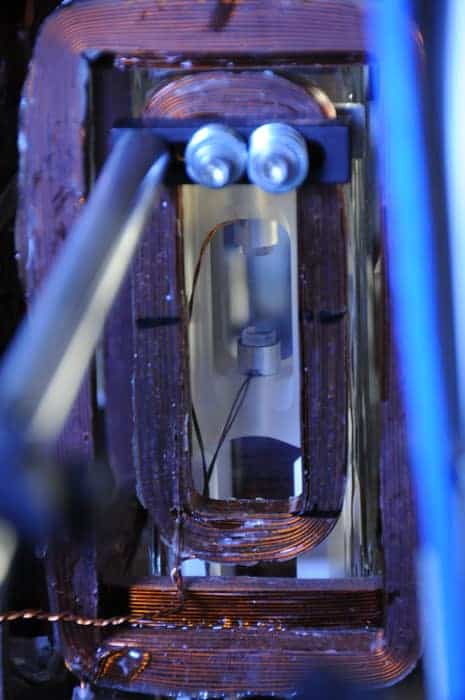
A new type of laser in which light is emitted collectively by several atoms at the same time – rather than just one – has been unveiled by physicists in the US. Their “superradiant” laser, which is based on a concept first described in 1954 by the US physicist Robert Dicke, has the potential to be up to 1000 times more stable than the best conventional visible lasers. It could therefore be used to boost the performance of the most advanced atomic clocks, although much more development work will be needed before that goal is fulfilled.
At the heart of a conventional laser is a mirrored cavity in which light bounces back and forth to create a standing wave that is related to the wavelength of the laser’s output. The cavity contains atoms or molecules that have been “pumped” into a high-energy state. When a photon interacts with an atom or molecule, an exact copy of the photon is produced and these two photons can go on to create four photons, and so on. If one of the mirrors is thin enough to allow some of the light to pass through it, a coherent beam of identical photons will stream out of the cavity to make the laser beam.
In principle, all these photons should have exactly the same wavelength, which is defined by the distance between the mirrors. But in a real laser, the mirrors tend to vibrate, which means that the distance varies in time about an average value, thus broadening the distribution of wavelengths of the light produced. Stabilizing the length of the cavity is therefore essential to create lasers with very fixed frequencies that can be used for atomic and optical clocks.
Standing wave of atoms
The new laser, which has been built by James Thompson and colleagues at the University of Colorado, Boulder, avoids the problem of unstable cavities because the coherence of its emitted light is not maintained by the light in the standing wave (and hence the length of the cavity) but rather by a standing wave in the electrical polarization of the atoms. Indeed, nearly all of the light produced in the cavity escapes without ever bouncing off a mirror, which means that the width of the emitted light is not affected by mirror vibrations. Remarkably, the atomic standing wave can be maintained even when there is – on average – less than one photon bouncing back and forth in the cavity.
To create their laser, Thompson and colleagues began with an ultrahigh-vacuum chamber containing a vapour of rubidium atoms. The atoms were laser cooled to about 20 µK and then held between two mirrors by creating a 1D optical lattice using a conventional laser operating at a frequency different to that of the superradiant laser. Separate lasers at the sides of the cavity were then used to pump the atoms.
The excited atoms begin to emit photons with wavelengths tuned to the length of the cavity. But while most of these photons escape immediately to produce the laser beam, an extremely small number bounce back and forth in the cavity to create a standing wave in the electrical polarization of the rubidium atoms. Amazingly, the laser can operate even when there are, on average, only 0.2 photons trapped in the cavity.
The team found that the laser was extremely stable with respect to the frequency of the laser used to place the atoms in the pumped state – although in absolute terms, the device is nowhere near as stable as the best cavity-stabilized lasers. In addition, the team was only able to run the superradiant laser for about 140 ms.
Potential “game-changer”
For practical metrological applications, a superradiant laser would have to operate continuously for hours or days, according to Mark Oxborrow of the National Physical Laboratory in the UK. However, Oxborrow told physicsworld.com that the laser has the potential to be a “game-changer” in terms of how extremely stable lasers are made. He believes that the superradiant laser could become very useful if its stability was able to compete with the best cavity-stabilized devices, which would require more than a thousand-fold improvement.
Ultimately, Thompson and colleagues believe the technology could be 1000 times more stable than conventional lasers, which would require a whopping million-fold improvement in stability. While this would be a remarkable improvement over the current design, Oxborrow points out that such a huge improvement in performance is not unprecedented when a new way of doing things is introduced.
Thompson says that the team is now examining how to make a superradiant laser using atoms in which the excited state has a longer lifetime. An example of such an atom is strontium, which is used in optical clocks. Superradiant lasers could even be used in long-baseline interferometry experiments that search for gravitational waves, which rely on light with a very precise wavelength. Thompson also believes that the laser could be used in large-aperture telescopes, in which light captured in different parts of the world is combined to create an image.
The laser is described in Nature.


